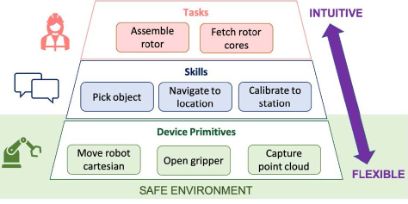- News
Researchers develop flexible and intuitive robot system
14.07.2022 Traditional automation solutions are not viable for companies manufacturing products in small quantities and many different variants. That’s why researchers at the Institute for Human Centered Engineering HuCE at Bern University of Applied Sciences (BFH) are developing a collaborative robot system that combines the efficiency of automation with human flexibility.
Robots are now indispensable in production and assembly halls. However, permanently installed automation solutions are not financially viable for many companies, especially those with a wide product range but small batch sizes. A system must also be easily adaptable so that it can be converted quickly to perform new tasks in line with production requirements and flexible enough to enable the integration of new products. Aiming to develop ad-hoc, flexible automation solutions, researchers at the Institute for Human Centered Engineering HuCE at Bern University of Applied Sciences (BFH) are working with an industry partner on a collaborative robot system which can be adapted flexibly and easily and is intuitive to use.

Human-machine interface
The system being developed as part of the AgileRobotics research project, which is supported by Innosuisse, aims to combine the efficiency of automation with human flexibility. This requires an intelligent human-machine interface that enables human-defined targets to be converted into specific robot actions. The interface consists of a three-tier architecture: Tasks, skills and device primitives (see image). The tasks correspond to natural language and the device primitives to the machine’s capabilities. Skills are object-oriented and serve as a communication bridge. New tasks are created by combining skills and new skills are developed through the combination of device primitives. This means the robot can be adapted to perform new tasks without programming knowledge. The researchers are adopting a design-thinking approach to the human-machine interface. It will be developed in cooperation with employees who will test it on an ongoing basis as low technology acceptance is one of the main reasons for the failure of the introduction of cobotic systems. However, successful implementation can help employees to develop their skills, acquire new competencies and diversify their roles. This increases the active participation of employees in the development and continual improvement of the robot system – the company’s human capital – and contributes towards enhancing motivation, quality and efficiency.
The research group, led by Sarah Dégallier Rochat from the Laboratory for Computer Perception and Virtual Reality, has specialised in the development of more intuitive human-machine interfaces after implementing several projects. The AgileRobotics project will build on the results of the ongoing ‘Cobotics, digital skills and the re-humanization of the workspace’ project of the SNSF programme ‘FNP77 – Digital Transformation’.
